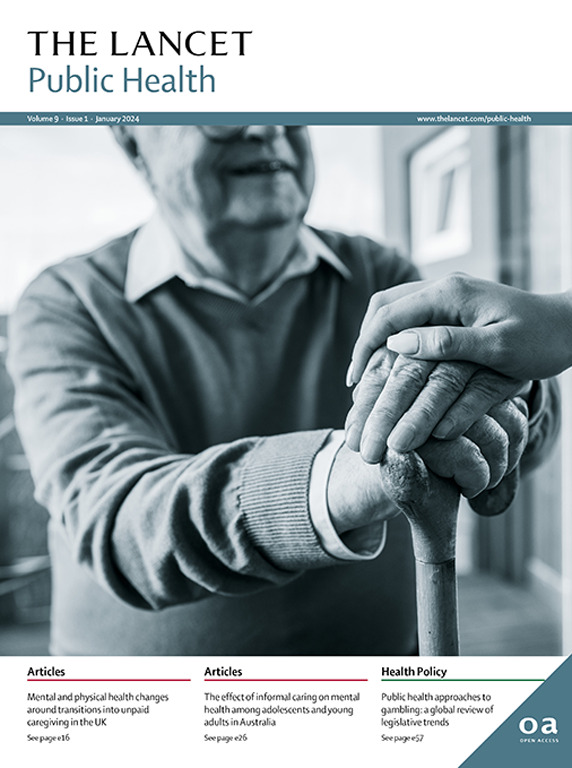Human papillomavirus-based cervical screening and long-term cervical cancer risk: a randomised health-care policy trial in Sweden
IF 25.4
1区 医学
Q1 PUBLIC, ENVIRONMENTAL & OCCUPATIONAL HEALTH
引用次数: 0
Abstract
Background
Human papillomavirus (HPV)-based cervical screening is a globally recommended public health policy. Randomised clinical trials find superior performance of primary HPV-based screening compared with cytology for preventing cervical cancer. However, additional evidence from real-world public health policies is needed. In preplanned secondary analysis of a randomised health-care policy trial in Sweden we aimed to evaluate which policy provided better protection against invasive cervical cancer, after two full rounds of screening.Methods
The organised cervical screening programme in the capital region of Sweden invited all women aged 30–64 years and eligible for screening to a randomised health-care policy trial of HPV-based versus cytology-based screening. During 2014–16, 395 725 eligible women were randomly assigned (non-concealed) to either policy and the invasive cervical cancer incidences over 8 years of follow-up were compared. Intention-to-screen analyses included all invited women and per-protocol analyses the women that attended baseline screening according to protocol. This trial is registered with ClinicalTrials.gov, NCT01511328.Findings
Women invited to HPV-based cervical screening had a 17% lower invasive cervical cancer risk compared with women invited to cytology (hazard ratio [HR] 0·83, 95% CI 0·70–0·98). Women participating in HPV-based screening had a 28% lower invasive cervical cancer risk compared with women participating with cytology (HR 0·72, 95% CI 0·54–0·95). Adverse events were a higher number of referrals to colposcopy with biopsy in the HPV policy (15 832 [7·5%] of 212 199 in intention to screen analyses and 9968 [9·0%] of 110 176 per protocol at baseline) than in the cytology policy (12 650 [6·9%] of 183 120 in intention to screen analyses, and 7179 [7·9%] of 90 821 per protocol at baseline). Women who were HPV-negative at baseline had invasive cervical cancer risks of 1·3 (95% CI 0·6–2·4) per 100 000 person-years, whereas the risk for women with normal cytology was 9·1 (6·7–11·8) per 100 000 person-years. HPV-positive women with negative cytology triage had invasive cervical cancer risks of 79·2 per 100 000 person-years and HPV 16 or HPV 18-positive women with negative cytology triage had risks of 318·2 per 100 000 person-years.Interpretation
This randomised policy trial found HPV-based screening to be superior for preventing invasive cervical cancer in the real-world setting. A single baseline HPV-negative test was associated with a very low invasive cervical cancer risk after 8 years. However, HPV positivity with negative cytology triage was associated with high invasive cervical cancer risks.Funding
Region Stockholm, Swedish Cancer Society, and European Union Horizon 2020.基于人类乳头瘤病毒的宫颈筛查与长期宫颈癌风险:瑞典的随机医疗保健政策试验
背景基于人乳头瘤病毒(HPV)的宫颈筛查是全球推荐的公共卫生政策。随机临床试验发现,与细胞学检查相比,基于人乳头瘤病毒的初级筛查在预防宫颈癌方面效果更佳。然而,还需要更多来自真实世界公共卫生政策的证据。瑞典首都地区组织的宫颈筛查计划邀请所有符合筛查条件的 30-64 岁女性参加基于 HPV 的筛查与基于细胞学的筛查的随机医疗政策试验。2014-16 年间,395 725 名符合条件的女性被随机分配(非隐蔽)到其中一种政策中,并对 8 年随访期间的侵袭性宫颈癌发病率进行了比较。意向筛查分析包括所有受邀妇女,而按协议分析则包括根据协议参加基线筛查的妇女。该试验已在 ClinicalTrials.gov 登记,编号为 NCT01511328。研究结果与接受细胞学检查的妇女相比,受邀接受基于 HPV 的宫颈筛查的妇女患侵袭性宫颈癌的风险降低了 17%(危险比 [HR] 0-83,95% CI 0-70-0-98)。与参加细胞学检查的妇女相比,参加基于HPV的筛查的妇女患浸润性宫颈癌的风险降低了28%(危险比为0-72,95% CI为0-54-0-95)。与细胞学筛查政策相比,HPV 政策中转诊至阴道镜检查并进行活检的人数较多(意向筛查分析中,212 199 人中有 15 832 人[7-5%]转诊至阴道镜检查;基线时,110 176 人中有 9968 人[9-0%]转诊至阴道镜检查)(意向筛查分析中,183 120 人中有 12 650 人[6-9%]转诊至阴道镜检查;基线时,90 821 人中有 7179 人[7-9%]转诊至阴道镜检查)。基线时 HPV 阴性的妇女患浸润性宫颈癌的风险为每 10 万人年 1-3 例(95% CI 0-6-2-4),而细胞学检查正常的妇女患浸润性宫颈癌的风险为每 10 万人年 9-1 例(6-7-11-8)。HPV阳性、细胞学分流结果为阴性的妇女患浸润性宫颈癌的风险为每 10 万人年 79-2 例,HPV 16 或 HPV 18 阳性、细胞学分流结果为阴性的妇女患浸润性宫颈癌的风险为每 10 万人年 318-2 例。单次基线 HPV 阴性检测与 8 年后极低的浸润性宫颈癌风险相关。然而,HPV 阳性且细胞学分流结果为阴性与高侵袭性宫颈癌风险相关。
本文章由计算机程序翻译,如有差异,请以英文原文为准。
求助全文
约1分钟内获得全文
求助全文
来源期刊

Lancet Public Health
Medicine-Public Health, Environmental and Occupational Health
CiteScore
55.60
自引率
0.80%
发文量
305
审稿时长
8 weeks
期刊介绍:
The Lancet Public Health is committed to tackling the most pressing issues across all aspects of public health. We have a strong commitment to using science to improve health equity and social justice. In line with the values and vision of The Lancet, we take a broad and inclusive approach to public health and are interested in interdisciplinary research.
We publish a range of content types that can advance public health policies and outcomes. These include Articles, Review, Comment, and Correspondence. Learn more about the types of papers we publish.
 求助内容:
求助内容: 应助结果提醒方式:
应助结果提醒方式:


